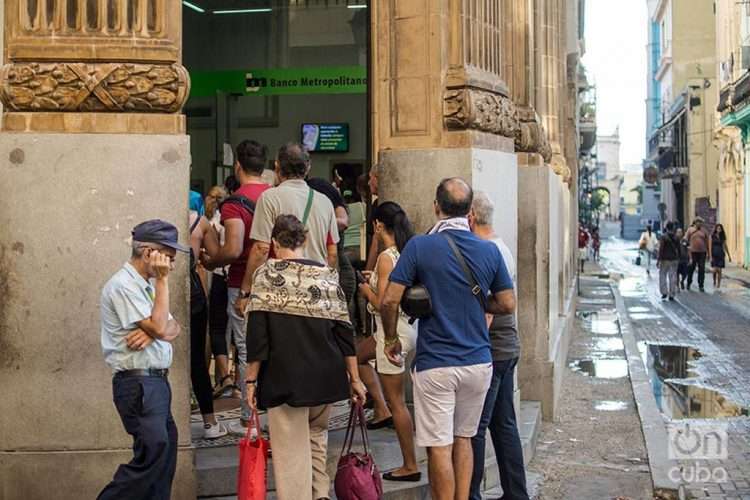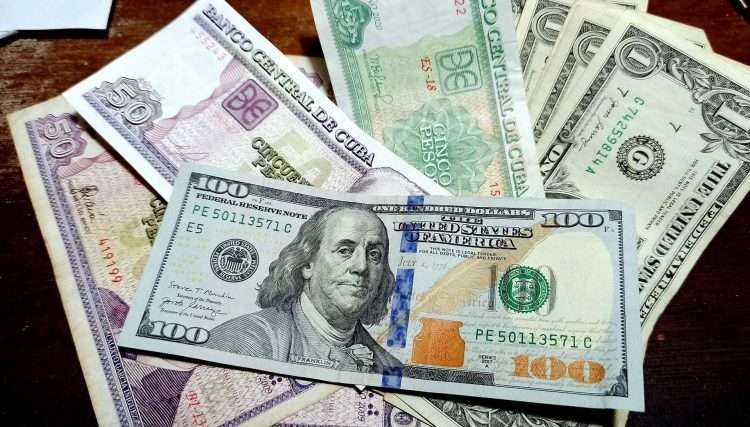On April 10, through Resolution 63 of 2023 of the Central Bank of Cuba (BCC), the Cuban government announced the bankability of the dollar, a measure that has caused intense exchanges of criteria among the population, both on social networks and outside them, and, of course, among economists of different generations and approaches.
More recently, Casas de Cambio S.A. (Cadeca) announced that as of this Monday, April 17, users will be able to deposit cash in USD at all their offices.
For some it is the “right path”; for others, “a step back” in the midst of an economic policy marked by shoving and zigzagging that does not provide effective answers to the great problems of Cuba today, from feverish inflation to the expansion of inequalities and poverty.
In this context, we have convened several experts on the process of internal crisis and change on the island since the fall of socialism in Eastern Europe until the so-called Task of Reorganization, in order to be able to access different points of view on this new move.
How is this measure related to the Reorganization? What would be its effects in the short and medium term? The economists respond.
Pavel Vidal
The relationship of the Cuban financial system with the USD has been very irregular. It is hard to understand its logic. It has been part of the government’s preference to only introduce partial, fragmented changes and managing industries and markets in a segmented way (“handmade” economy).
Since the 1990s, when it was decided to promote tourism, remittances and foreign investment, they have been dealing with this dilemma. On the one hand, dollars arrive that later have difficulties to place and use in the international financial market due to sanctions. It is the currency of the country that sanctions you. Nor have they been able to stabilize and make the Cuban peso functional in the exchange system, something that could not be corrected with the 2021 monetary reform. Rather, it has worsened in the last three years with triple-digit inflation and a sustained devaluation of the exchange rate in the informal market. Therefore, partial dollarization is once again the solution.
The government may have figured out that promoting re-dollarization is easier in the short term than assuming the political cost of applying austerity measures, raising taxes, reducing spending and closing state enterprises to curb price increases.
Moving forward with partial institutional dollarization facilitates the entry of remittances through formal channels, provides liquidity to commercial banks and accounts in freely convertible currency, and closes off spaces for the informal currency market.
On the other hand, the disadvantage remains that partial dollarization with dual exchange rates is a second best, since it generates financial distortions and inequalities; that is, it does not ensure inclusive and sustained economic growth in the long term.
One element that may have influenced the decision is that the BCC found a new way to be able to deposit/use these dollars in cash in the international financial market, despite the U.S. financial sanctions.
The underlying issue has always been the problem they have in putting these dollars to work in the international market; especially after the super fines imposed on international banks that were accepting dollars from Cuba and other sanctioned nations.
Julio Carranza
As a specific measure, the error was not made now, but rather when the bankability of the dollar was suspended. This time, with slightly forced arguments, there is a return to normality in that sense.
However, seeing it as it should be — that is, not in an isolated way —, it is part of a situation of monetary chaos in the Cuban economy, aggravated by the impact of the Reorganization. It is necessary to see the whole. As an isolated measure, it is good to have rectified this, but looking at the whole, as it should be, the problem is the monetary and exchange rate chaos, which cannot be solved with isolated measures.
The exchange rate is still far from being under the adequate control of monetary policy, in the midst of which, on the one hand, minority interests thrive and benefit and, on the other, general interests of the economy and society are affected.
I have expressed it many times and I repeat it now, without time to explain it in detail: the solutions for the Cuban economy involve completing a deep and comprehensive economic reform. Of course, without ignoring the effects of the genocidal blockade that persists on the nation; but there is much to do and to transform, despite that pressure.
Tamarys L. Bahamonde
Resolution 63 of 2023 of the BCC authorizes bank deposits in dollars. This policy, although it is not directly part of the so-called Task of Reorganization, is the result of the economic impact of the policies designed during the Reorganization. Decisions taken in recent years (including the long-term absence of a formal dollar market) increased informal market transactions and led to a significant devaluation of the Cuban peso.
The policies adopted ignored the existence of the informal market and the pressures that the scarcity of supply and the absence of an official dollar market would generate on the informal exchange rate, therefore, on the Cuban peso.
The so-called bankability of the dollar, although expected, represents a setback in the initial intention of the Reorganization, which was the recovery of the Cuban peso as a measure of exchange and hoarding. Despite being a logical decision, given the circumstances, it affects the ability of the peso to play its role as a currency. It is to be expected that deposits in dollars, and even transactions in dollars, will be prioritized instead of the use of the national currency.
Socially, it will deepen existing inequities by keeping open the gap between those who have access to dollars and those who do not.

These monetary policies, without adequate accompaniment by economic policies that improve productive conditions, increasing the supply of goods and services, and imposing a system of redistribution of resources that benefits vulnerable citizens, always result in greater inequality and social injustice.
For the economy, the current scenario is even more complex than the one that gave rise to the Reorganization. Different currencies in circulation, with different exchange rates, as well as the bank dollar (freely convertible currency) controlling a substantial part of retail trade, introduce financial distortions that are very difficult to correct.
Pedro Monreal
Regarding the Reorganization, it was officially said that once the process had started it would be impossible to go back; the “patching up” measures express a continuist obstinacy. An incoherent model does not necessarily collapse quickly. It could last and so could its impoverishing effect.
Capped prices, partial dollarization, online import setups, atrophied exchange markets, inspectorates, and now the reacceptance of USD in banks, are not only marginal actions, but also contradict the model of the Reorganization.
The components of the Reorganization (monetary and exchange unification, macro devaluation of the peso, end of subsidies, increase in wages and prices) ended up enhancing the effects of the pandemic and placing the country in a stagflation from which no way out is in the horizon.
The Reorganization started with a “sequence” contradiction that ruined it in a short time: an attempt was made to modify relative prices without previously carrying out a structural reform of the productive apparatus; especially, of the enterprises, the market and property.
The decision to accept physical USD to credit accounts in freely convertible currency should be understood as one of the several twists and turns to the ambitious but badly designed and badly applied reform of the “Reorganization.”

It was already banked in USD. What is new is the physical USD to try to increase remittances, something in which the previous banking mechanism and the rickety state exchange market failed.
Propping up the freely convertible currency is not the right direction, according to the official “model” itself.
Omar Everleny
The measure to allow physical dollars to enter the banking system again contradicts what was announced in the Task of Reorganization.
It must be remembered that at the end of 2020 President Díaz-Canel, accompanied by Raúl Castro, announced on Cuban TV that monetary unification would begin on January 1, 2021 and, consequently, that within six months the CUC would disappear, since it was a decisive step in the monetary reorganization of the country. This would leave the Cuban peso (CUP) as the only official currency, with a single official conversion rate of 24 pesos per dollar.
The current measure is positive in terms of the fact that the State expects that the population will quickly begin to deposit dollars in the banking system to access the stores in freely convertible currency. However, it would be necessary to see in reality what that behavior would be.
But the State must go further; that is, allow the remittances that Cubans receive via Western Union to be paid in dollars; that the official conversion rate from dollars to Cuban pesos be closer to the informal rate; and that the new stores that are opened in retail trade with foreign companies work with physical dollars, as happened in Venezuela with the recovery of its retail trade.
Action alone would not achieve what the country needs for its recovery. Although to the extent that the supply of dollars increases, the rate of pesos to dollars in the informal market could fall.
The cons of the measure can be several; among them, that it tends to further distance the idea of having a market in which only the currency in which salaries and other payments are made in the country is used.










